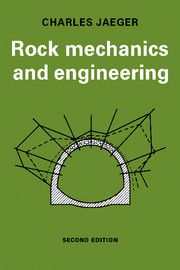Book contents
- Frontmatter
- Contents
- Preface
- Preface to the first edition
- Part 1 Introduction to rock mechanics
- Part 2 Rock material and rock masses
- Part 3 Rock mechanics and engineering
- 9 Rock slopes and rock slides
- 10 Galleries, tunnels, mines and underground excavations
- 11 Rock mechanics and dam foundations
- Part 4 Case histories
- References
- Appendix 1 Comments on the bibliography
- Appendix 2 Measurement conversion tables
- Appendix 3 Table of geological formations and earth history
- Appendix 4 Some petrographic properties of rocks
- Author Index
- Index of geographical names, dam sites, reservoirs, tunnels and caverns
- Subject Index
10 - Galleries, tunnels, mines and underground excavations
Published online by Cambridge University Press: 04 August 2010
- Frontmatter
- Contents
- Preface
- Preface to the first edition
- Part 1 Introduction to rock mechanics
- Part 2 Rock material and rock masses
- Part 3 Rock mechanics and engineering
- 9 Rock slopes and rock slides
- 10 Galleries, tunnels, mines and underground excavations
- 11 Rock mechanics and dam foundations
- Part 4 Case histories
- References
- Appendix 1 Comments on the bibliography
- Appendix 2 Measurement conversion tables
- Appendix 3 Table of geological formations and earth history
- Appendix 4 Some petrographic properties of rocks
- Author Index
- Index of geographical names, dam sites, reservoirs, tunnels and caverns
- Subject Index
Summary
Introduction
Tunnelling engineering techniques are very closely related to rock mechanics and mining. It is not possible to summarize here the vast amount of information now available on this subject, therefore only specific aspects will be discussed.
First to be mentioned among tunnels is the Thames tunnel built between 1826 and 1843 by Brunei. The excavation of the 12 849-m-long Mont Cenis tunnel between France and Italy, in 1870–1, was one of the major undertakings at the end of the last century. It was rapidly followed by others in America (Hoosac tunnel, 1873, Canadian tunnels on the Canadian Pacific Line, 1875) and in England with the Severn tunnel in 1873 and the Blackwall tunnel in 1891. The first very large Alpine tunnel, the 14·98-km-long St. Gotthard tunnel was opened in 1882, followed shortly by the Arlberg tunnel (10 240 m) in 1884. The longest are the two Simplon tunnels both of 19 803 m, built in 1906 and 1922. The twentieth-century underground railway systems and hydro-power developments gave fresh impetus to tunnelling techniques. More recently, large road and power tunnels have been built through mountain ridges. The Gotthard Road tunnel (Switzerland), now under construction, will be 16·32 km long and the Orange–Fish power and irrigation tunnel in South Africa, 82·45 km.
Considerable progress has been made during the past twenty years in drilling techniques, the quick removal of soil and in lining methods. Roof bolting has been introduced on a large scale.
- Type
- Chapter
- Information
- Rock Mechanics and Engineering , pp. 226 - 324Publisher: Cambridge University PressPrint publication year: 1979



